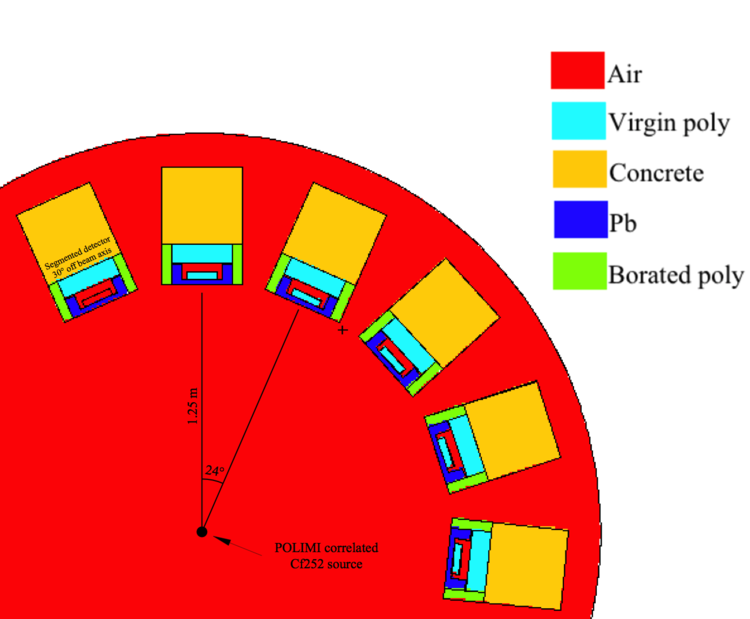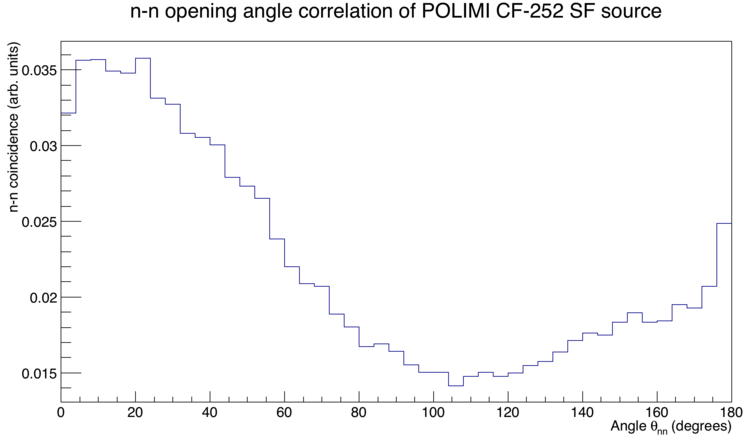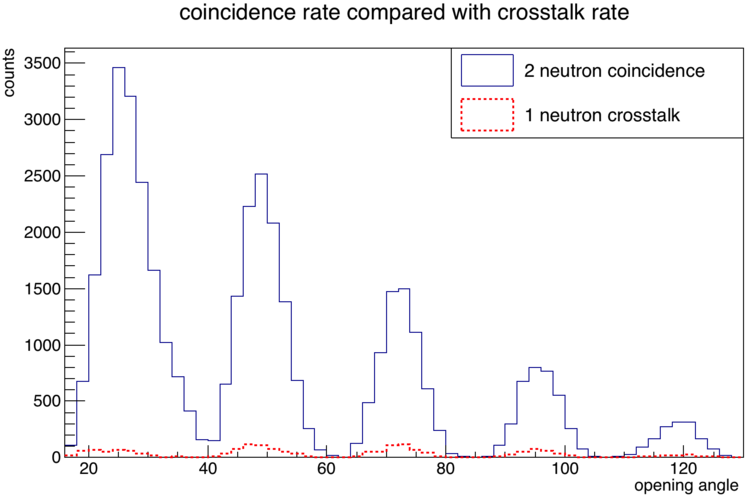Difference between revisions of "CrossTalk"
| (63 intermediate revisions by the same user not shown) | |||
| Line 1: | Line 1: | ||
Go back [[MCNP simulations]] | Go back [[MCNP simulations]] | ||
| − | = | + | =Old simulations= |
| − | An array of 6 detectors are placed radially at a distance of 1 meter from | + | [[crosstalk_simulation_2016]] |
| + | =Simulation geometry= | ||
| + | An array of 6 detectors are placed radially at a distance of 1 meter from a correlated CF-252 source. The image below shows a top down view of the simulation geometry. The detector setups have a vertical extent of 30". | ||
| − | [[File: | + | [[File:Crosstalkgeom2017.png|750 px]] |
| − | = | + | =Simulation detector physics= |
| − | The detector physics used in the simulation | + | The detector physics used in the simulation are MCNP-POLIMI's default treatment for plastic organic scintillators. POLIMI uses electron equivalent light output (MeVee) for simulating detector response. I assumed the detectors have a neutron energy deposition threshold of 0.2 MeV, giving an equivalent light output threshold of 0.03 MeVee. |
| − | + | Neutron energy deposition from collisions with both hydrogen and carbon are converted to electron equivalent light output (MeVee). All neutron collisions that occur within a pulse collection time window of 10 ns of each other are converted to MeVee and summed. If the cumulative light output of a pulse exceeds the 0.03 MeVee threshold, then a detection is registered. The value 0.03 MeVee was chosen because it corresponds to a mean neutron energy deposit of 0.2 MeV. The detectors in the simulation had a 55% efficiency for detecting CF-252 neutrons. | |
| − | Neutron energy deposition from collisions with hydrogen and carbon are converted to electron equivalent light output (MeVee) | ||
| − | = | + | =Simulation source= |
| − | The | + | POLIMI is used to simulate a correlated CF-252 SF source. The source neutrons are correlated by angle, energy, and multiplicity. The mean multiplicity of the source is 2.7 neutrons/fission. A correlated n-n opening angle distribution (shown below) is produced by dividing the opening angle distribution of neutrons selected from single fissions, by the opening angle distribution of neutrons selected from separate fissions. |
| − | + | [[File:POLIMI Correlation.png|750px]] | |
| − | and | + | =Simulation results= |
| + | The number of n-n coincidences was a factor of 36 times greater than the number of n-crosstalk coincidences. n-n coincidence is defined as an event as two or more neutrons from the same fission registering a hit in two different detectors. If two neutrons are detected in coincidence, then that makes one n-n opening angle, three coincident neutrons makes three n-n opening angles, four neutrons makes six opening angles, and so on. An n-crosstalk coincidence event is defined as a singe source neutron (or any secondaries it produces) registering a hit in two different detectors. | ||
| + | [[File:CrosstalkVScoincidence.png|750px]] | ||
| − | + | ||
| + | =MCNP POLIMI input deck= | ||
| + | [[File:POLIMICrossTalkSimulation2017.txt]] | ||
| − | |||
| − | |||
| − | |||
| − | |||
| − | |||
| − | |||
| − | |||
| − | |||
| − | |||
| − | |||
| − | |||
| − | |||
| − | |||
| − | |||
| − | |||
| − | |||
| − | |||
| − | |||
Go back [[MCNP simulations]] | Go back [[MCNP simulations]] | ||
Latest revision as of 21:58, 22 February 2017
Go back MCNP simulations
Old simulations
Simulation geometry
An array of 6 detectors are placed radially at a distance of 1 meter from a correlated CF-252 source. The image below shows a top down view of the simulation geometry. The detector setups have a vertical extent of 30".
Simulation detector physics
The detector physics used in the simulation are MCNP-POLIMI's default treatment for plastic organic scintillators. POLIMI uses electron equivalent light output (MeVee) for simulating detector response. I assumed the detectors have a neutron energy deposition threshold of 0.2 MeV, giving an equivalent light output threshold of 0.03 MeVee.
Neutron energy deposition from collisions with both hydrogen and carbon are converted to electron equivalent light output (MeVee). All neutron collisions that occur within a pulse collection time window of 10 ns of each other are converted to MeVee and summed. If the cumulative light output of a pulse exceeds the 0.03 MeVee threshold, then a detection is registered. The value 0.03 MeVee was chosen because it corresponds to a mean neutron energy deposit of 0.2 MeV. The detectors in the simulation had a 55% efficiency for detecting CF-252 neutrons.
Simulation source
POLIMI is used to simulate a correlated CF-252 SF source. The source neutrons are correlated by angle, energy, and multiplicity. The mean multiplicity of the source is 2.7 neutrons/fission. A correlated n-n opening angle distribution (shown below) is produced by dividing the opening angle distribution of neutrons selected from single fissions, by the opening angle distribution of neutrons selected from separate fissions.
Simulation results
The number of n-n coincidences was a factor of 36 times greater than the number of n-crosstalk coincidences. n-n coincidence is defined as an event as two or more neutrons from the same fission registering a hit in two different detectors. If two neutrons are detected in coincidence, then that makes one n-n opening angle, three coincident neutrons makes three n-n opening angles, four neutrons makes six opening angles, and so on. An n-crosstalk coincidence event is defined as a singe source neutron (or any secondaries it produces) registering a hit in two different detectors.
MCNP POLIMI input deck
File:POLIMICrossTalkSimulation2017.txt
Go back MCNP simulations


